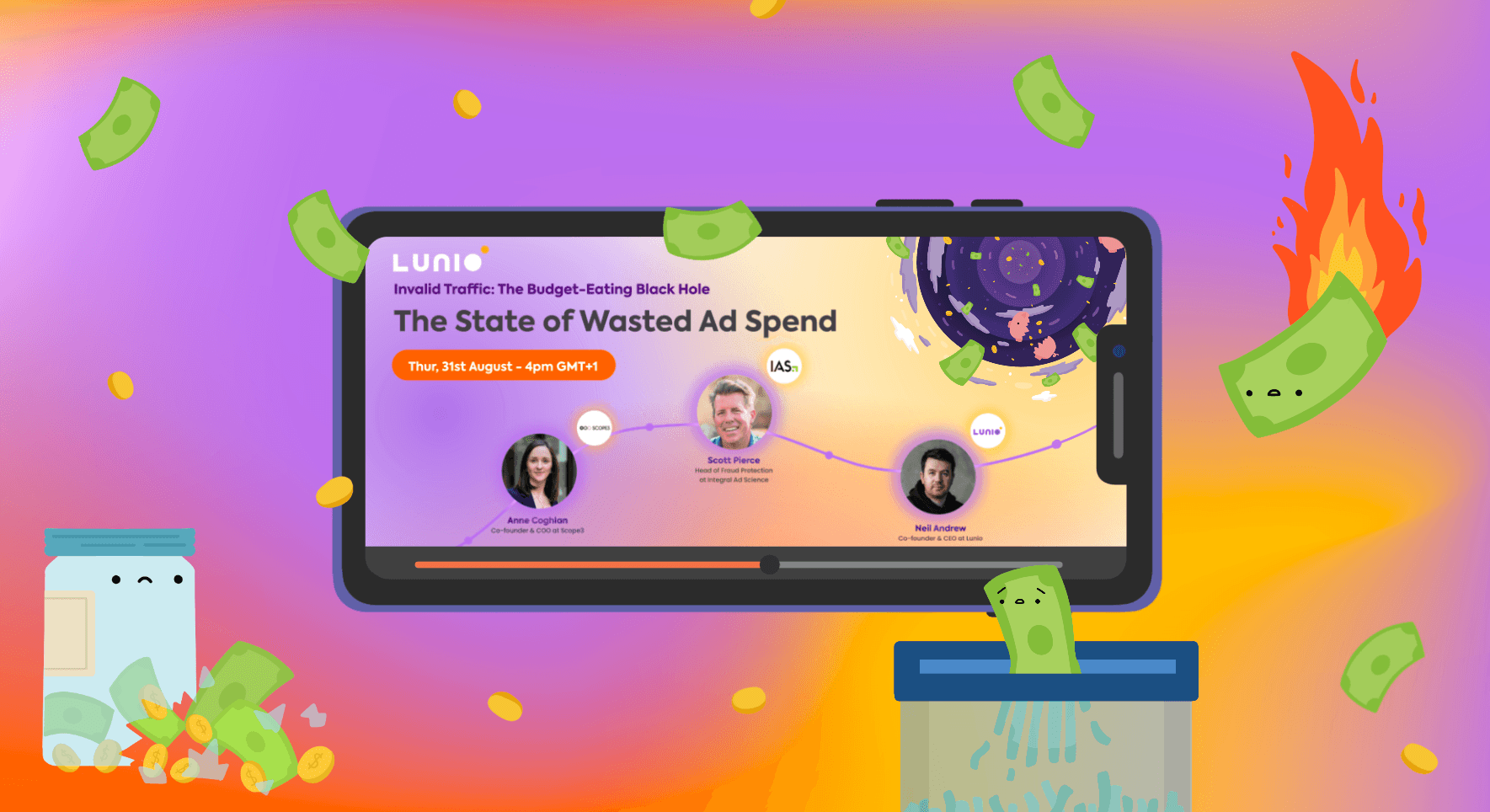Invalid traffic (IVT) has been a concern for performance marketers for years. And there’s no shortage of recent headlines related to the issue.
For example, X’s (formerly Twitter) bot problem is now infamous thanks to the legal disputes prior to Elon Musk’s takeover in October 2022.
Failing to fix the bot problem paired with changes to content moderation rules which significantly increase brand risk caused advertisers to abandon the platform in droves. As reported by the BBC, X has lost half of its advertising revenue since it was bought by Musk.
While news stories like this highlight universal agreement in the digital advertising industry about the problems and inefficiencies invalid traffic creates, there are still common misunderstandings about what IVT actually is, how it’s generated, and how to detect it.
So we set out to answer these questions and more in our recent webinar. In this second instalment of our three-part Wasted Ad Spend Report series, we spoke to Lunio’s CTO, David Triger, and Head of Demand Generation, Leo Pizarro. The conversation was hosted by Lunio’s Content Manager, James Deeney.
During the session, David and Leo shared insights on the current state of invalid traffic in 2023, and gave tips marketers can use to reduce IVT rates and minimise wasted ad spend. The main themes and content covered in this webinar stem from Lunio’s 2024 Wasted Ad Spend report which is available to download for free, no-form fill required. Expect to learn:
- Average IVT rates across all major ad platforms
- IVT rates by industry, region, and company size
- Lost revenue opportunities due to IVT for 2023 & 2024
- Top 3 concerns affecting performance marketers in 2023
- Strategies to minimise wasted ad spend across all channels
- How to reduce your paid media carbon emissions
- And lots more!
Download the 2024 Wasted Ad Spend Report
Webinar Recording
Webinar Timestamps
- 00:00 – Intro
- 06:24 – The launch of TikTok search ads
- 08:50 – Agenda
- 10:00 – Defining invalid traffic: The good & bad
- 12:25 – General IVT vs Sophisticated IVT
- 17:00 – What are “fake users” on social platforms?
- 21:55 – What does IVT look like? Signs to look out for
- 31:00 – The current state of IVT in 2023
- 37:00 – What are ad networks doing about IVT
- 41:17 – How Lunio detects IVT ad networks don’t catch
- 45:14 – Marketing best practices to reduce wasted spend on IVT
- 48:00 – Q&A
End Wasted Spend With Lunio
Concentrate 100% of your budget on real buyers by automatically excluding fake traffic. Get a free 14-day audit to see how much you’re spending on IVT.
TL;DR – Key Takeaways
- Invalid traffic is defined as website visits that don’t come from a real person with genuine interest. It can include bots (both good and bad), fake users, misattributed accidental clicks, malicious clicks from competing advertisers, and otherwise invalid visitors that have zero chance of converting to customers.
- Not all bots are malicious. There is a lot of “good” bot activity online that helps the internet and websites function properly. An example are Google and Bing crawler bots which index all newly published web pages so they can be ranked in search engine results pages (SERPs).
- Accidental clicks from real humans are much harder to detect than invalid traffic coming from bots. It requires an entirely different detection method, and ad networks are currently not well-equipped to filter out these kinds of invalid clicks.
- General invalid traffic (GIVT) is mostly non-malicious bot activity. It consists mainly of web crawlers and automated activity from open source tools. GIVT is limited to ISP-assigned IP addresses and typically can’t execute JavaScript, making it very easy for ad platforms and legacy click fraud solutions to detect.
- Sophisticated invalid traffic (SIVT) uses methods to attempt to mimic human behaviour, making it much harder to detect. It often comes in the form of “low and slow” attacks, whereby it attempts to identify the traffic patterns associated with a website to blend in with that activity in a way that doesn’t look suspicious.
- “Fake users” can refer to spam leads and fake social media profiles. Unlike SIVT, fake users are plainly visible to advertisers. But it’s often difficult to determine whether they are legitimate at first glance. With the rise of AI image and language generation tools, fake user activity has become even more prevalent on social media.
- When experimenting with Meta’s Advantage+ “Audience Expansion” tool with Lunio protection switched off, Leo generated 200 webinar signups within 24 hours, at a cost-per-lead of £0.07. On further inspection, every single one of these leads turned out to be fake, highlighting the ongoing issues with automated audience targeting.
- There are simply too many variables (e.g. the time of the click, the associated campaign, geographic location, the user’s keyboard etc) associated with invalid traffic for humans to be able to reliably spot patterns in the data, even when presented to them in full. In contrast, machine learning models can predict within seconds whether activity happening right now resembles previous activity that was almost certainly invalid.
- Major data discrepancies between CRM platforms and web analytics platforms commonly experienced by marketers are often the result of IVT. Lunio helps to reduce these discrepancies by preventing analytics platform data being skewed by IVT.
- The most obvious signs of IVT in marketing analytics data are peaks in traffic with significantly lower than average conversion rates, and unexpectedly high cost-per-acquisition or cost-per-sale metrics.
- With Lunio protection switched on, one of the most common outcomes is a reduction in bounce rates and a significant uptick in session duration. If you commonly experience 90%+ bounces rates with an average session duration of <5 seconds, it warrants further investigation to determine how much invalid traffic is hitting your landing page.
- The 2023 Imperva Bad Bot Report found that in 2022, nearly half (47.4%) of all internet traffic came from bots, a 5.1% increase over the previous year. This trend is likely to continue due to Moore’s Law, which states that computing power tends to double every two years. Given the power of hardware is growing much faster than the population, invalid traffic rates are likely to continue increasing over the coming years.
- The advent of tools like ChatGPT has made it much easier for individual bad actors to create bots with very limited coding / technical ability. This is another contributing factor leading to increased prevalence of invalid activity online.
- Fake and invalid clicks are generally cheaper than legitimate ones. This can create a negative feedback loop whereby automated campaign types (e.g. Performance Max) continue to seek out more and more junk conversions which never translate into revenue, simply because the acquisition costs are lower.
- IVT rates were much lower on Google channels. Lunio’s Wasted Ad Spend report found that 5.5% of traffic coming from Google channels was invalid while 17.5% of traffic coming from non-Google channels was invalid. This is partly due to the fact that Google simply processes much more data than other ad platforms. Google handles more than 8.5 billion searches every single day, while Meta averages 22 billion visits per month.
- Google is more proactive than other ad networks in combating invalid traffic. They have even created a knowledge base about IVT to educate advertisers and show them how they can help prevent it.
- There is little financial incentive for ad networks to clamp down aggressively on sophisticated IVT. When analysing traffic in real-time to determine its validity, it becomes exponentially more expensive the longer it takes machine learning models to make a decision. SIVT is harder to detect, and when comparing seconds vs minutes of decision time, it corresponds to at least a tenfold increase in associated costs.
- A combination of pre-bid optimisation (e.g. IAS) and post-click protection (e.g. Lunio) can work hand in hand. Post-click data reveals insights about on-site behaviour to detect and exclude invalid traffic at a level not possible with viewability data only. Pre-bid impression-level data reveals opportunities to maximise viewability and engagement rates for every ad served before the clicks even occur.
- When running Google Display campaigns use Lunio’s 100k placement exclusion list to limit your exposure to IVT coming from low quality domains, apps, and YouTube channels.
- If you’ve identified a list of IP addresses you think might be fraudulent, you can cross-check these against the AbuseIP Database before excluding them. You can also automate this by asking ChatGPT to create a Python script to check a list of IPs from a CSV using the free API of AbuseIPDB.
- Unless overall reach is your primary goal, always turn off audience expansion and advertising partner networks to limit your exposure to IVT.
Useful Links & Further Reading
Download Lunio’s Wasted Ad Spend Report 2024
Download Lunio’s Performance Marketing Efficiency Playbook
Watch Lunio’s IVT Webinar in Partnership w/ IAS & Scope3
AbuseIPDB – IP address abuse reports
Lunio’s 100k Display placement exclusion list
Google’s Invalid Traffic knowledge base
Lead Gen Fraud: How to Identify & Prevent Fake Leads, Lunio
ChatGPT for PPC: 7-Step Framework to Automate Ad Campaigns, Lunio
GIVT vs SIVT, Lunio
How to Generate Qualified Leads With Paid Social [Lunio Webinar]
End Wasted Spend With Lunio
Concentrate 100% of your budget on real buyers by automatically excluding fake traffic. Get a free 14-day audit to see how much you’re spending on IVT.




